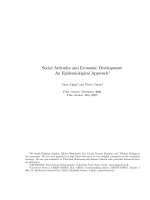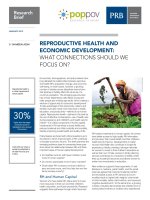Social science knowledge and economic development an institutional design perspective
Bạn đang xem bản rút gọn của tài liệu. Xem và tải ngay bản đầy đủ của tài liệu tại đây (6.33 MB, 361 trang )
Social Science Knowledge and
Economic Development
Economics, Cognition, and Society
This series provides a forum for theoretical and empirical investigations of social
phenomena. It promotes works that focus on the interactions among cognitive processes,
individual behavior, and social outcomes. It is especially open to interdisciplinary books
that are genuinely integrative.
Editor:
Timur Kuran
Editorial Board:
Tyler Cowen
Avner Greif
Diego Gambetta
Viktor Vanberg
Titles in the Series
Ulrich Witt, Editor.
Explaining Process and Change: Approaches to Evolutionary
Economics
Young Back Choi.
Paradigms and Conventions: Uncertainty, Decision Making, and
Entrepreneurship
Geoffrey M. Hodgson.
Economics and Evolution: Bringing Life Back into
Economics
Richard W. England, Editor. Evolutionary Concepts in Contemporary Economics
W. Brian Arthur. Increasing Returns and Path Dependence in the Economy
Janet Tai Landa. Trust, Ethnicity, and Identity: Beyond the New Institutional
Economics of Ethnic Trading Networks, Contract Law, and Gift-Exchange
Mark Irving Lichbach. The Rebel s Dilemma
Karl-Dieter Opp, Peter Voss, and Christiane Gem.
Origins of a Spontaneous
Revolution: East Germany, 1989
Mark Irving Lichbach. The Cooperator s Dilemma
Richard A. Easterlin. Growth Triumphant: The Twenty-first
Century in Historical
Perspective
Daniel B. Klein, Editor.
Reputation: Studies in the Voluntary Elicitation of Good
Conduct
Eirik G. Furubotn and Rudolf Richter.
Institutions and Economic Theory: The
Contribution of the New Institutional Economics
Lee J. Alston, Gary D. Libecap, and Bernardo Mueller.
Titles, Conflict, and Land
Use: The Development of Property Rights and Land Reform on the Brazilian
Amazon Frontier
Rosemary L. Hopcroft.
Regions, Institutions, and Agrarian Change in European
History
E. L. Jones. Growth Recurring: Economic Change in World History
Julian L. Simon. The Great Breakthrough and Its Cause
David George. Preference Pollution: How Markets Create the Desires We Dislike
Alexander J. Field. Altruistically Inclined? The Behavioral Sciences, Evolutionary
Theory, and the Origins of Reciprocity
David T. Beito, Peter Gordon, and Alexander Tabarrok, Editors.
The Voluntary City:
Choice, Community, and Civil Society
Randall G. Holcombe.
From Liberty to Democracy: The Transformation of American
Government
Omar Azfar and Charles A. Cadwell, Editors.
Market-Augmenting Government: The
Institutional Foundations for Prosperity
Stephen Knack, Editor. Democracy, Governance, and Growth
Phillip J. Nelson and Kenneth V. Greene. Signaling Goodness:
Social Rules and
Public Choice
Vernon W. Ruttan.
Social Science Knowledge and Economic Development: An
Institutional Design Perspective
Social Science Knowledge and
Economic Development
An Institutional Design Perspective
Vernon W. Ruttan
UN I V E R SI TY
Ann Arbor
OF
MI C HI G AN P R E S S
To the social scientists who serve on the staffs of the national
and international development agencies. They have become
increasingly effective in bringing social science knowledge to
bear on the design and implementation of development policies
and programs.
Copyright © by the University of Michigan 2003
All rights reserved
Published in the United States of America by
The University of Michigan Press
Manufactured in the United States of America
@ Printed on acid-free paper
2006
2005
2004
2003
4
3
2
1
No part of this publication may be reproduced, stored in a retrieval system,
or transmitted in any form or by any means, electronic, mechanical,
or otherwise, without the written permission of the publisher.
A elP catalog recordfor this book is available from the British Library.
Library of Congress Cataloging-in-Publication Data
Ruttan, Vernon W.
Social science knowledge and economic development / Vernon W. Ruttan.
p. cm. - (Economics, cognition, and society)
Includes bibliographical references and index.
ISBN 0-472-1 1355-0 (Cloth: alk. paper)
I. Economic development. 2. Applied sociology. 3. Technological
innovations-Economic aspects-Developing countries. 4. Organizational
change-Economic aspects-Developing countries. I. Title. II. Series.
HD75 .R87 2004
2003012783
338.9--d c21
We contract the boundaries of our subjects, and of our
sub-subjects, to make them more manageable; and we are
enabled to do this because our academic specialization is
in fact happening in the Ilreal world." But it is not all that is
happening in the world.
-Sir John Hicks
(1969)
Contents
List of Figures
List of Tables
List of Boxes
Preface
Xl
XUI
Xlll
xv
PART I
CHAPTER I
Induced Institutional Innovation
What Is Institutional Innovation?
Demandfor Institutional Innovation
The Supply of Institutional Innovation
Toward a More Complete Model of
Induced Innovation
3
4
9
16
22
PART II
CHAPTER 2
CHAPTER
Cultural Endowments and Economic Development
Cultural Endowments in
Development Economics
Why Anthropology?
Deconstructing Development
Constructing Culture
Perspective
3 The Sociology of Development
and Underdevelopment
Why Sociology?
What Happened to Modernization Theory?
Alternative Sociologies
Rational Choice, Social Norms,
and Development
Perspective
33
33
42
52
59
63
68
69
71
79
87
97
viii
Contents
CHAPTER
4 What Happened to Political Development?
Political Development in Development Economics
Political Science and Political Development
The Political Basis of Economic Development
The Economic Foundations of Political Development
Political Power and Political Development
Institutional Design
Perspective
100
101
106
112
117
119
125
131
CHAPTER
5 Growth Economics and Development Economics
Classical and Schumpeterian Growth
Modern Growth Theory
Dialogue with Data
Growth Economics as Development Economics
A More Comprehensive Growth Economics?
Perspective
A Postscript on Method
135
136
139
1 50
154
163
165
167
PART III
CHAPTER
6 Technology Adoption, Diffusion, and Transfer
The Convergence of Traditions
The Diffusion of Diffusion Research
International Technology Transfer
Resistance to Technology
The Divergence of Traditions
171
171
184
190
193
197
CHAPTER
7 Social Capital and Institutional Renovation
The Kombi-Naam Cultural Endowment
Understanding the Kombi-Naam
Renovating the Kombi-Naam as a
Development Organization
Groupements Naam and Technical Innovation
The Continuity and Replicability of the
Groupements Naam
Conclusions
200
202
203
CHAPTER
8 Religion, Culture, and Nation
Fundamentalist Religion and Economic Development
Culture and Development
Nationalism and Nation Building
Perspective
205
207
209
213
215
215
226
240
248
Contents
CHAPTER 9
ix
Why Foreign Economic Assistance?
Donor Self-Interest
Ethical Considerations
Lessons from Experience
A Foreign Economic Assistance Future?
In Conclusion
251
252
255
260
266
268
Postscript
271
Appendix: Definitions of Culture
Bibliography
Indexes
273
277
327
PART IV
CHAPTER
10
Figures
1.1.
1.2.
2.1.
2.2.
3.1.
5.1.
6.1.
6.2.
6·3·
6·4·
Interrelationships between changes in resource
endowments, cultural endowments, technology,
and institutions
Macro- and micro level propositions: effects of
religious doctrine on economic organization
A Marxist model. The forces o f prod�ction and the
relations of production together make up the
economic base or mode of production.
The cultural materialism model
Linear and interactive models o f the relations
between advances in scientific and technical knowledge
Real per capita gross domestic product i n the
United States, 1 870-1994
The epidemic model
Cumulative number o f diffusion research
publications by year
Number of diffusion publications by rural
sociologists by year
Number of horses and cars in the
United States, 1850-2000
23
28
46
47
86
152
1 76
178
179
188
Tables
Factor Shares o f Rice Output per Hectare,
1976 Wet Season
1 . 2 . Comparison between the Imputed Value of
Harvesters' Share and Imputed Cost of
Gamma Labor
6 . 1 . Major Diffusion Research Traditions
1.1.
12
14
172
Boxes
2.1.
3.1.
4. 1
5.1.
5.2.
5.3.
Postmodernism
Rational Choice
Institutional Design Principles
The Keynesian (Harrod-Domar) Model
The Neoclassical (Solow-Swan) Growth Model
Endogenous Growth Theory (Romer-Lucas)
54
88
127
140
142
145
Preface
In the first several decades after World War II there was a dramatic
increase in interest in the development of non-Western societies in all
of the social sciences. Prior to World War II interest in non-Western
societies by social scientists was dominated by ethnographic studies of
primitive isolates or studies of native cultures by applied anthropolo
gists in the service of colonial administration. The emergence of new
states committed to rapid economic growth contributed to the rapid
emergence of a new field of inquiry into the process of development in
each of the social sciences.
In the literature of the I950S there was a presumption that economic
growth would be strongly influenced by cultural endowments and
institutional development. This resulted in the rapid emergence of dis
ciplinary subfields such as development sociology, political develop
ment, and development administration. Historians, geographers, legal
scholars, and historians also began to explore the contribution that
their particular disciplinary skills and insights might offer to the under
standing of development process or development practice.
The early expectation that these several streams of inquiry might
merge to enrich each other has only recently begun to materialize. In
some fields, such as political development, early enthusiasm was
replaced by serious doubt about the viability of the political develop
ment research agenda. In other fields, interest in development studies
faded along with the decline of financial support by foundations and
official development assistance agencies as the Cold War wound down.
Interest by economists in the contribution of other social science disci
plines declined as economic approaches to policy analysis and plan
ning became more formalized.
The rapid pace of economic development in a number of developing
countries during the I960s and I970S seemed to confirm the perspective
that economic development could be left to the economists. During the
I980s, however, much of the optimism about the pace of development
in both Western and non-Western economies eroded. By the early
xvi
Preface
1 990S institutional and cultural explanations for stagnation or dis
torted development again emerged as important themes in both popu
lar and professional literature.
My own earlier work on the role of institutional innovation in eco
nomic development (and with colleagues Yujiro Hayami and Hans
Binswanger) largely involved the extension of neoclassical microeco
nomics in attempts to understand (I) how changes in resource endow
ments and technical change induced institutional innovations and (2)
how institutional change induced changes in resource endowment and
technology. My work departed from the mainstream "new institu
tional economics" in that it drew more heavily on the work of
Theodore W. Schultz and Leonid Hurwicz than on that of Ronald
Coase for its inspiration. In this book I go beyond my earlier concerns
to explore what development economists can (or should) learn from
other social scientists, and from macroeconomic growth theory, in
their attempts to design more effective development policies and insti
tutions. A consistent theme in this book is that advances in social sci
ence knowledge represent a powerful source of economic development.
Theoretical inquiry carried on apart from a continuing dialogue with
data is arid.
This book originated in a program of summer reading that began
in the mid-1980s. The initial result was a series of articles published
mainly in the 1 990s. In the spring of 2000 I was able to interest the
University of Michigan Press in publishing a book, drawing on these
earlier articles, under the title Social Science Knowledge and Economic
Development. The Press informed me, however, that they were not
interested in simply publishing a collection of my oId articles. But
they would be interested in a revised, updated, and integrated treat
ment. The title of the book was chosen very deliberately. It is about
the contribution of social science knowledge to the project of eco
nomic development.
I would like to thank Professor Henry J. Bruton, the University of
Michigan Press reviewer, for his helpful comments on the proposed
book. He has continued to offer useful comments and suggestions on
subsequent drafts. Christopher Clague, Greta Friedemann-Sanchez,
Robert T. Holt, Timur Kuran, Douglass C. North, and Stephen Gude
man have read and made recommendations on earlier drafts of the
manuscript. Heidi Van Schooten has typed, retyped, and edited por
tions of the manuscript.
Preface
xvii
I have used earlier drafts of these chapters in an interdisciplinary
graduate seminar offered by the MacArthur Program at the University
of Minnesota. The book has benefited from my students' comments. I
anticipate that the book may be of interest to behavioral economists
and to other'social scientists. It should also be of interest to social sci
ence professionals in development assistance agencies.
PART I
CHAPTER I
Induced Institutional Innovation
The central premise of this book is that the demand for social science
knowledge is derived from the demand for institutional change. I If this
view is correct then any claim by the social science disciplines and
related professions for substantial public support depends on a credi
ble promise that advances in social science knowledge represent an
efficient source of institutional innovation. Another way of articulat
ing the same point is that advances in social science knowledge reduce
the cost of institutional change. I employ the term cost in its broadest
sense, to include the psychological, the social, and the political as well
as the economic costs of institutional change.
The interpretation of technical and institutional change as endoge
nous rather than exogenous to the economic system is a relatively new
development in economic thought. In work published in the 1 970S
Yujiro Hayami, Hans Binswanger, and I extended the theory of
induced technical change and tested it against the history of agricul
tural development in the United States and Japan (Hayami and Ruttan
1971; Binswanger and Ruttan 1978). It is now generally accepted that
the theory of induced technical change provides very substantial
insight into the process of agricultural development for a wide range of
developed and developing countries. Industrial economists and eco
nomic historians have drawn extensively on the theory of induced tech
nical change in attempting to interpret differential patterns of produc
tivity growth among firms, industries, and countries and over time
(Thirtle and Ruttan 1987, 68-72). In the late 1980s growth theory was
revitalized by the introduction of new models of endogenous economic
growth (Romer 1986; Lucas 1988; chap. 5, this vol.).
I. In this chapter I draw heavily on Ruttan and Hayami (1984). I am indebted to Henry J.
Bruton, James F. Oemke, and Christopher K. Clague for comments on an earlier draft of this
chapter.
3
4
Social Science Knowledge and Economic Development
The demonstration that technical change can be treated as largely
endogenous to the development process does not imply that the
progress of either agricultural or industrial technology can be left to an
"invisible hand" that drives technology along an "efficient" path deter
mined by relative resource endowments. The capacity to advance
knowledge in science and technology is itself a product of institutional
innovation-"the great invention of the nineteenth century was the
invention of the method of invention" (Whitehead 1925, 96).
In the case of agriculture, for example, in both the United States and
Japan, much of the technical change that has led to growth of output
per hectare was, until very recently, produced by public sector institu
tions. These institutions-state (or prefectoral) and federal (or
national) agricultural experiment stations-obtained their resources in
the political marketplace and allocated their resources through
bureaucratic mechanisms (Hayami and Ruttan 1985, 206-52; Ruttan
2001b, 1 79-234). The success of the theory of induced technical change
gives rise, therefore, to the need for a more careful consideration of the
sources of institutional innovation and design.
In this chapter I elaborate a theory of institutional innovation in
which shifts in the demand for institutional innovation are induced by
changes in relative resource endowments and by technical change. I
also consider the impact of advances in social science knowledge and
of cultural endowments on the supply of institutional change. After
examining the forces that act to shift the supply and demand of insti
tutional innovation, the elements of a more general model of institu
tional change are presented.
What Is Institutio n a l I n novation ?
There is considerable disagreement regarding the concept of institu
tion. Institutions are commonly defined as the organizations and rules
of a society that facilitate coordination among people by helping them
form expectations that each person can reasonably hold in dealing
with others. They reflect the conventions and ideologies that have
evolved in different societies regarding the behavior of individuals and
groups relative to their own behavior and the behavior of others. In the
area of economic relations they have a crucial role in establishing
expectations about the rights to use resources in economic activities
and about the partitioning of the income streams resulting from eco
nomic activity: "institutions provide assurance respecting the actions
Induced Institutional Innovation
5
of others, and give order and stability to expectations in the complex
and uncertain world of economic relations. " 2
In my work I find that an inclusive definition that includes organiza
tions is most useful, which is consistent with the view expressed by both
Commons (1950, 24) and Knight (1952, 51). The more inclusive
definition is employed in order to be able to consider changes in the
rules or conventions that govern behavior (I) within economic units
such as firms and bureaucracies, (2) among economic units as in the
cases of the rules that govern market relationships, and (3) between eco
nomic units and their environment, as in the case of the relationship
between a firm and a regulatory agency. It includes policy, mechanism,
and system innovations.3 The distinction that I make between institu
tions and cultural endowments is that institutions are the formal rules
and arrangements that govern behavior among and within organiza
tions, while cultural endowments are the informal codes and norms that
influence individual and group behavior. The state is a useful example.
It is an organization. It is also a source of formal rules and relationships
within itself and between itself and private agents (Aoki 2001, 151-79).
In order to perform the essential role of forming reasonable expec
tations in dealings among people, institutions must be stable for an
extended time period. But institutions, like technology, must also
change if development is to occur. Anticipation of the latent gains to
be realized by overcoming the disequilibria resulting from changes in
factor endowments, product demand, and technical change represents
powerful inducements to institutional innovation (North and Thomas
1970; Schultz 1975; Binswanger and Deininger 1997). Institutions that
have been efficient in generating growth in the past may, over time,
come to protect the vested interests of some of their members in main
taining the status quo and thus become obstacles to further economic
development.4 The growing disequilibrium in resource allocation due
2. See Runge (1981b, xv). Formal analysis of the role of institutions in providing assurance
of stability in economic relationships emerged from dissatisfaction with the implications of
the assumption of strict dominance of individual strategy in modern welfare economics (Sen
1967; Runge 198Ia). North argues that shared ideological and ethical perspectives provide
assurance that is lacking in models built on the dominance of individual strategies (1981,
45-58).
3. In his more recent work, North employs a definition of institution that is similar to
anthropologists' use of the term culture (1991, 1 994) and to my use of the term cultural endow
ment (fig. 1 . 1). For the evolution of the term culture see the appendix.
4. The role of special interest "distributional coalitions" in slowing society's capacity to
adopt new technology and reallocate resources in response to changing conditions is a cen
tral theme in Olson (1982, 74).
6
Social Science Knowledge and Economic Development
to institutional constraints generated by economic growth creates
incentives for political entrepreneurs or leaders to organize collective
action to bring about institutional change.
This perspective on the sources of demand for institutional change is
similar, in some respects, to the traditional Marxist view.5 Marx con
sidered technological change to be the primary source of institutional
change. The induced innovation perspective is somewhat more com
plex in that it considers that changes in cultural endowments, factor
endowments, and product demand are also important sources of insti
tutional change. The definition of institutional change employed in this
book is not limited to the dramatic or revolutionary changes of the
type anticipated by Marx. Institutions such as property rights and
markets are more typically altered through the accumulation of sec
ondary or incremental institutional changes such as modifications in
contractual relations or shifts in the boundaries between market and
nonmarket activities (Davis and North 1971, 9) .
There is a supply dimension as well as a demand dimension in insti
tutional change. Advances in social science knowledge represent an
increasingly important source of shifts in the supply of institutional
innovations. Collective action leading to the implementation of insti
tutional innovations involves struggles among various vested interest
groups. Clearly, the process is much more complex than the clear-cut,
two-class conflict between property owners and the property-less as
assumed by Marx. The supply of institutional innovations is strongly
influenced by the cost of achieving social consensus (or of suppressing
opposition). The cost of implementing an institutional innovation
depends on the distribution of both economic and political resources.
It also depends critically on cultural tradition and ideology (such as
nationalism) that make certain institutional arrangements more easily
accepted than others.
Advances in knowledge in the social sciences (and in related profes
sions such as law, administration, planning, and social service) can
reduce the cost of institutional change in a manner somewhat similar
5. "At a certain stage of their development, the material forces of production in society
come in conflict with existing relations of production, or-what is but a legal expression for
the same thing-with the property relations within which they had been at work before.
From forms of development of the forces of production these relations turn into their fetters.
Then comes the period of social revolution. With the change of the economic foundation the
entire immense superstructure is more or less rapidly transformed" (Marx 1913, 11-12). For a
discussion of the role of technology in Marxian thought see Rosenberg (1982, 34-54).









